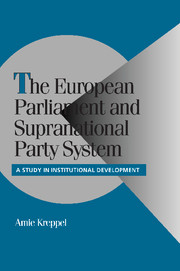Book contents
- Frontmatter
- Contents
- Figures
- Tables
- Acknowledgments
- 1 INTRODUCTION: THE EUROPEAN PARLIAMENT AND THE INSTITUTIONAL EVOLUTION OF LEGISLATURES
- 2 THEORIES OF LEGISLATIVE DEVELOPMENT AND THE EUROPEAN PARLIAMENT
- 3 THE DEVELOPMENT OF THE PARTY GROUP SYSTEM AND THE PARTY GROUPS
- 4 THE HISTORY OF THE EUROPEAN PARLIAMENT
- 5 THE INTERNAL DEVELOPMENT OF THE EUROPEAN PARLIAMENT: FROM COLLEGIALITY TO CONFLICT
- 6 THE DEVELOPMENT OF THE SUPRANATIONAL PARTY GROUP SYSTEM: CONFLICT AND COOPERATION IN THE COALITION FORMATION PROCESS
- 7 COOPERATION AND CO-DECISION: THE ROLE OF IDEOLOGY AND RULES
- 8 THE INTERNAL DEVELOPMENT OF THE SUPRANATIONAL PARTY GROUPS: AN ELUSIVE GOAL
- 9 CONCLUSIONS: UNDERSTANDING THE DEVELOPMENTAL PROCESS
- Appendices
- Bibliography
- Index
- Titles in the series
7 - COOPERATION AND CO-DECISION: THE ROLE OF IDEOLOGY AND RULES
Published online by Cambridge University Press: 18 December 2009
- Frontmatter
- Contents
- Figures
- Tables
- Acknowledgments
- 1 INTRODUCTION: THE EUROPEAN PARLIAMENT AND THE INSTITUTIONAL EVOLUTION OF LEGISLATURES
- 2 THEORIES OF LEGISLATIVE DEVELOPMENT AND THE EUROPEAN PARLIAMENT
- 3 THE DEVELOPMENT OF THE PARTY GROUP SYSTEM AND THE PARTY GROUPS
- 4 THE HISTORY OF THE EUROPEAN PARLIAMENT
- 5 THE INTERNAL DEVELOPMENT OF THE EUROPEAN PARLIAMENT: FROM COLLEGIALITY TO CONFLICT
- 6 THE DEVELOPMENT OF THE SUPRANATIONAL PARTY GROUP SYSTEM: CONFLICT AND COOPERATION IN THE COALITION FORMATION PROCESS
- 7 COOPERATION AND CO-DECISION: THE ROLE OF IDEOLOGY AND RULES
- 8 THE INTERNAL DEVELOPMENT OF THE SUPRANATIONAL PARTY GROUPS: AN ELUSIVE GOAL
- 9 CONCLUSIONS: UNDERSTANDING THE DEVELOPMENTAL PROCESS
- Appendices
- Bibliography
- Index
- Titles in the series
Summary
The previous examination of coalition formation across time focused exclusively on behavior during votes on resolutions. As the only form of decision making in the EP that has remained constant across time (in terms of both existence and relative importance) resolutions were an obvious choice to trace change in the patterns of coalition formation. Here, however, the focus will shift to examining patterns of coalition formation when, presumably, it matters most. That is when the EP can directly impact legislative outcomes. The cooperation and co-decision procedures grant the EP real legislative influence through amendment and veto powers. How the EP and the party groups behave under these procedures is of the utmost importance. If the party groups can effectively use the new powers granted to the EP, the possibility to effect legislative outcomes and achieve policy goals becomes a reality; if they cannot, the EP risks once again being relegated to observer status within the EU legislative process.
Therefore we must understand the extent to which the EP has been able to surmount the procedural challenges of the new procedures and come up with compromise proposals that are acceptable to the other EU institutions. In other words, we must find out if the party groups have been able to adapt not just to their new legislative role, but also to the restrictions placed upon their actions by the majority requirements of the second and third rounds and the institutional organization of the EU as a whole.
- Type
- Chapter
- Information
- The European Parliament and Supranational Party SystemA Study in Institutional Development, pp. 153 - 176Publisher: Cambridge University PressPrint publication year: 2001



